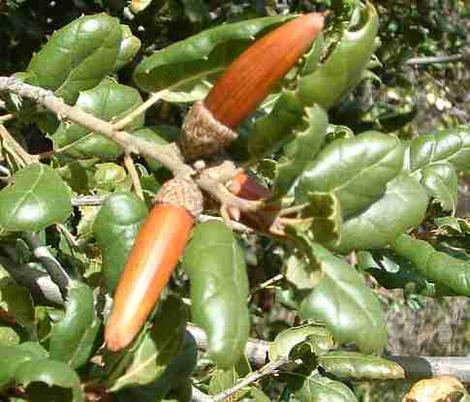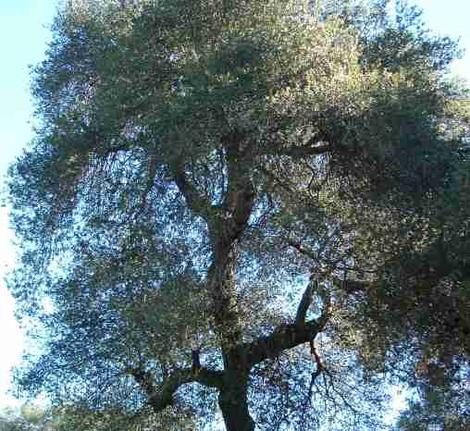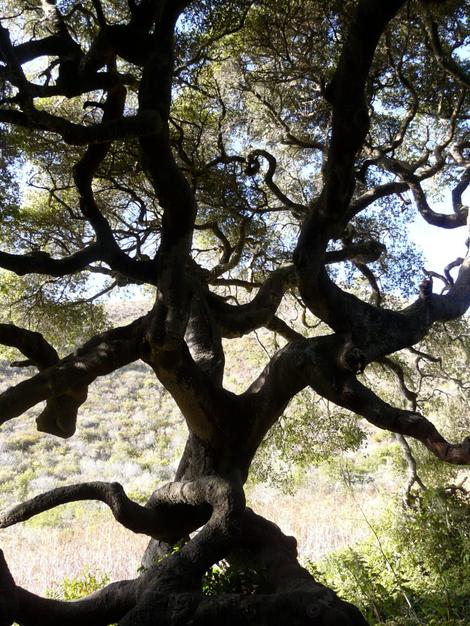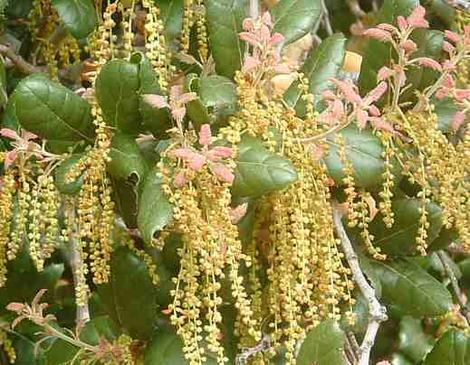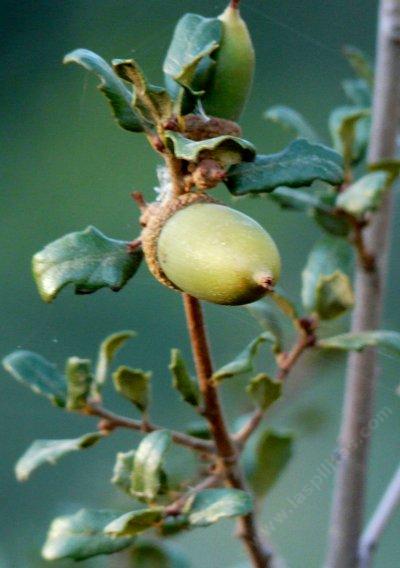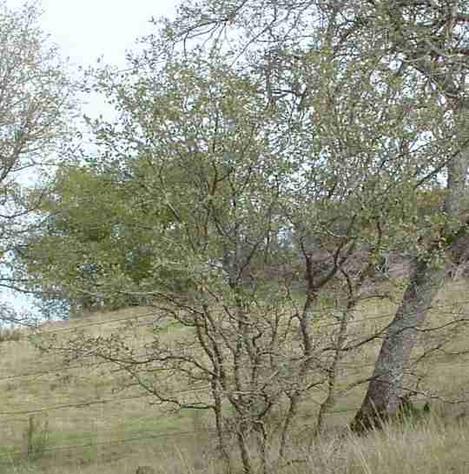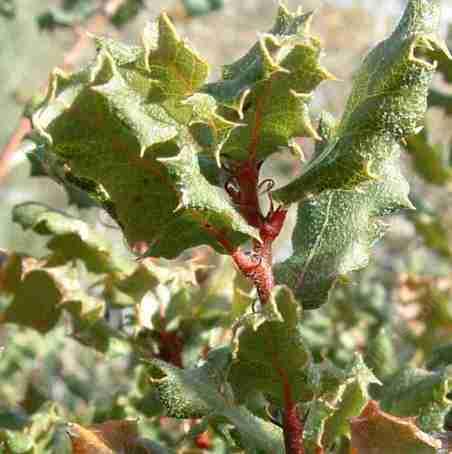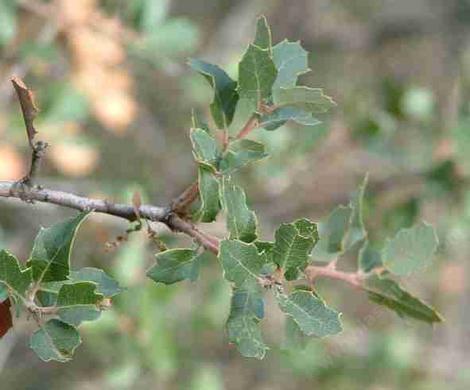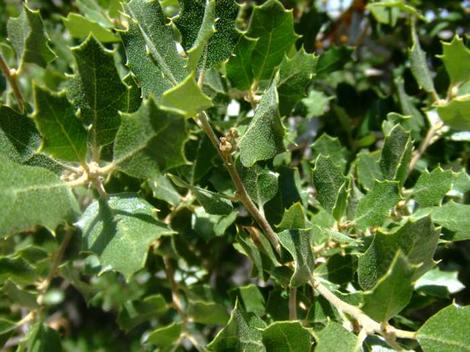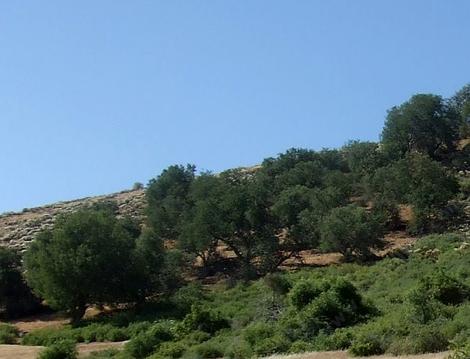California Oaks I
Quercus agrifolia(Coast Live Oak) and Quercus dumosa(scrub oak) are probably the most common oaks in California cities.
|
Acorn matures in one season (at end of new stems) |
Acorn matures in two seasons (on older stems) |
||
|
I. Evergreen Quercus agrifolia, Q. x alvordiana, Q.dumosa, Q. durata, Q. sadleriana, Q. turbinella |
II. Deciduous Quercus garryana var. breweri, Q. douglasii, Q.engelmannii, Q. garryana, Q. lobata |
III.Evergreen Quercus chrysolepis, Q. parvula, Q. tomentella, Q. vaccinifolia, Q. wislizenii, Lithocarpus densiflorus (Tanbark Oak) |
IV Deciduous Q. kelloggii, Q. palmeri |
| Oak relationship chart | |||
I. California Oaks that bear acorns on each season's growth and are evergreen.
One of the most common trees that you will see driving the roads of California in rural areas are oaks. Many of these trees are hundreds of years old. They are the dominant plants in many habitats. The wildlife of California depend heavily upon oaks. If we break down the state into sections where different types of oaks live, you can see the species of oak that you may commonly encounter in your area.
Coast Live Oak- Quercus agrifolia - with shiny, evergreen prickly leaves, that are usually rolled under. Not too fun to play around if you are barefoot. This oak is very drought tolerant, looks nice all year, and grows fairly quickly for an oak. Coast Live Oak will grow up high on the hillsides in central California (in the draws where there is more moisture). Under stress (drought, insects, diseases, etc.) the leaves will roll under and even fall off. No stress and the leaves are flat (like Interior Live Oak, Quercus wislizenii, BUT, for all oaks a little stress is good! Flat- leaved Coast Live Oaks are more susceptible to SOD (sudden oak death) or other diseases.
Coast live oak (Quercus agrifolia) acorns vary from short fat stubby ones that seem to be all cap, into the monsters shown here. We even have a tree in the area that bears crescent shaped ones that are longer than an inch and only a quarter inch wide and look kinda like a fish hook.
Quercus x ganderi is a natural hybrid that occurs in the San Diego area between the interior form of Coast Live Oak (Q. agrifolia var. oxyadenia) and Black Oak (Q. kelloggii).
There are all sorts of leaf and acorn variation for Coast Live Oak, so do not get excited because one tree has a bigger or smaller leaf.
It seems that every few years a budding botanist wanders out
of his or her ivory tower and discovers that there are bushy oaks
outside. Now these oaks do not key in the floras easily (keying is
wandering through a flora's (a book) selection process that is supposed
to be based primarily on reproductive parts of the plant). So, Mister
or Ms. hot shot botanist writes a paper describing his or her
“new oak. Every time a 'new' oak is described it leads to
more confusion and more 'new' oaks. These oaks below should probably
all be considered various forms of Scrub Oak
(Quercus dumosa).
Quercus berberidifolia- new name for Q. dumosa, given to new plants that are supposed to only occur in San Diego but are elsewhere. The landscape trade only recognizes old Q. dumosa, so in the name of 'restoration' the gene pool is being replanted with oaks from all over the state.
Quercus cornelius-mulleri (Very much like Q. john tuckeri or Q. xalvordiana. A wonderfully clean beautiful small tree. I actually figured this one out once.)
Quercus dumosa var. elegantula
Quercus durata var. gabrielensis (let's see you separate Q.durata from Q. dumosa by leaf roll, and this form has no leaf roll; maybe it's Q. dumosa?)
Quercus grandidentata (Q. engelmannii X Q. dumosa)
Quercus x howellii (Q. dumosa X Q. garryana)
Q. john tuckeri (Q. turbinella var. californica) probably was originally a hybrid between Q. douglasii and Q. dumosa
Quercus X kinselae (Q. dumosa X Q. lobata)
Quercus X macdonaldii (Q. dumosa X Q. lobata)
Quercus X townei (Q. dumosa X Q. lobata)
Quercus dumosa var. turbinella
AND, the live oaks have dwarf forms that can also mimic Quercus dumosa.
Quercus x alvordiana looks like what it probably is, a Blue Oak crossed with a Scrub Oak.(Quercus douglasii X Quercus dumosa)
Some forms of Quercus dumosa (Q. berberidifolia) looks very much like a dwarf Coast Live Oak (Quercus agrifolia) or Interior Live Oak (Quercus wislizenii).
Q. john
tuckeri (old name: Quercus turbinella ssp.
californica) is like a Q. dumosa but with fuzz on the top of the
leaf. But, then sometimes it's like an evergreen Blue Oak (Quercus
douglasii).
You can't even say all scrub oaks are scrubby. Some can become small trees with 12 diameter trunks and rarely a size of 30 feet. While others (many times on the same slope) reach a maximum height of six feet.
The floras make it sound easy to figure out the Quercus x alvordiana, Q. dumosa, Q. john tuckeri (or Q. turbinella), and all the other 'new' forms of Quercus dumosa. Isn't so. They morph even into a Blue Oak (Quercus douglasii). Some of the deciduous blue oaks (Quercus douglasii) look exactly like a Tucker's Oak (Quercus john tuckeri), some of the Quercus dumosa look to be hybrids with Quercus agrifolia (Coast Live Oak), some hybrids of Q. dumosa and Q. lobata (Valley Oak) exist, some of the blue oaks do not go deciduous and key to Q. john tuckeri but appear to be blue oaks in all other aspects.
Leather Oak (Quercus durata) is one of the many scrub oaks. The rolled leaf edges on a small tree, almost shrub, is the key. Use as a dwarf oak or as a 'tree' in a miniature forest.
Deer
Oak (Quercus sadleriana). This oak grows in lush northern
California shady or wet forests.
The only way to succeed is to fail, repeadedly, repeatabley, repeateditly, repetetely, ah, #@#!
